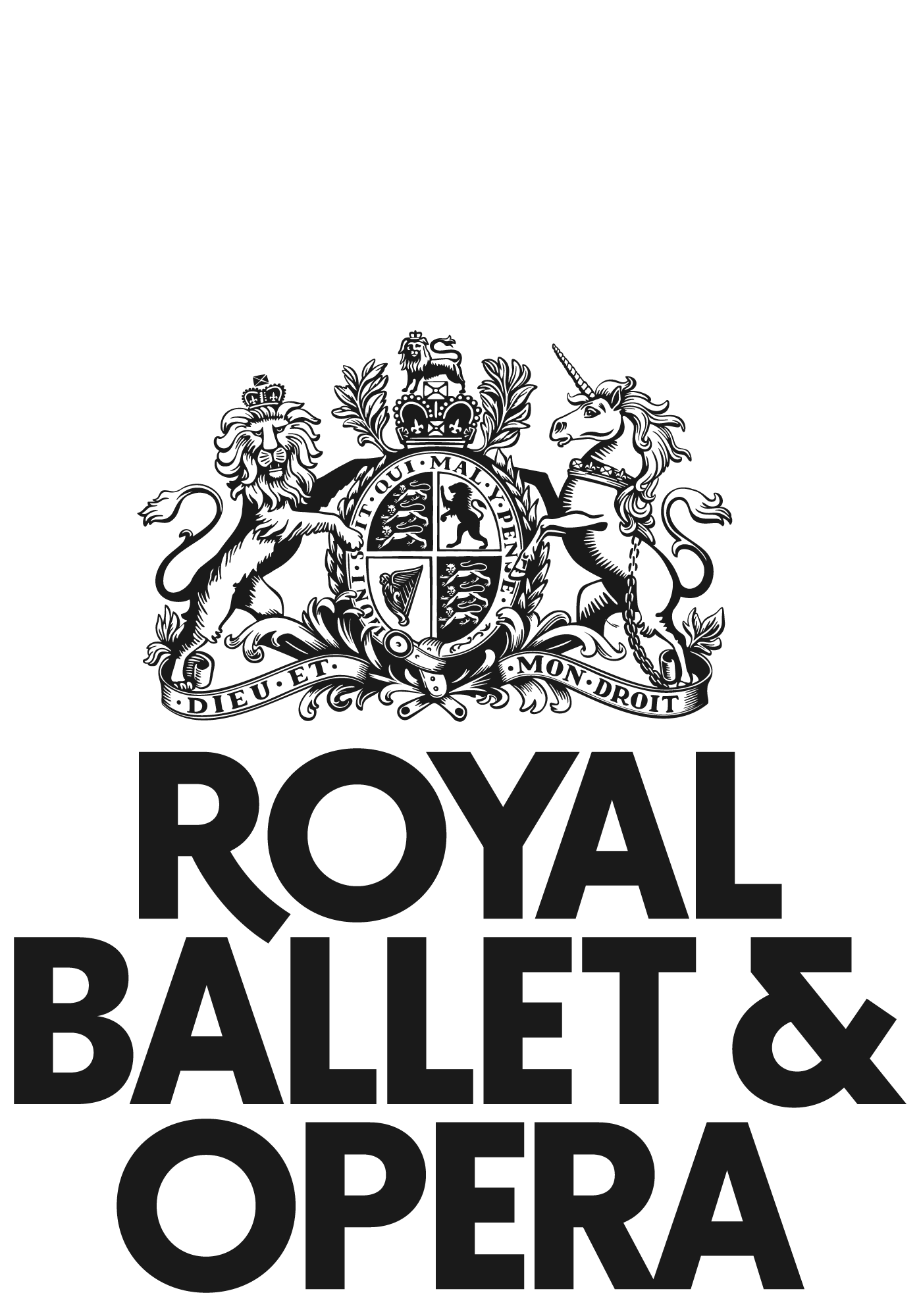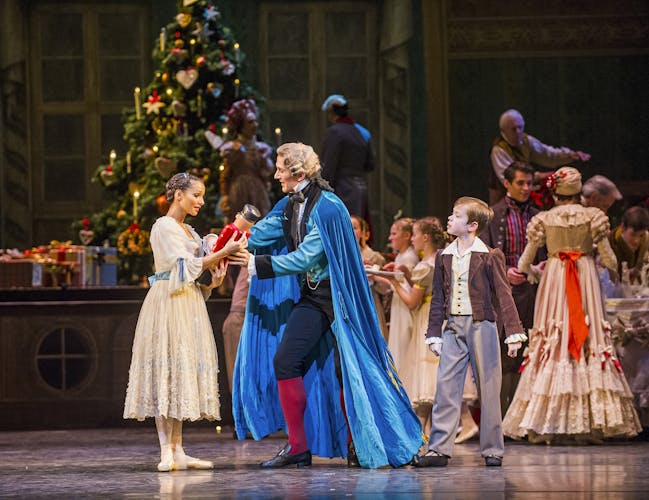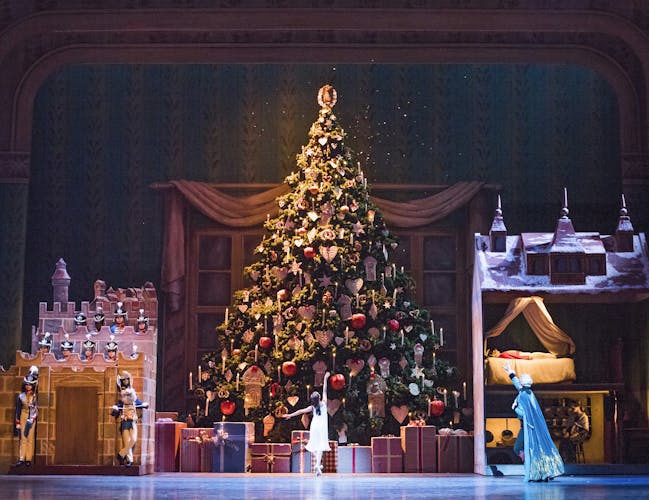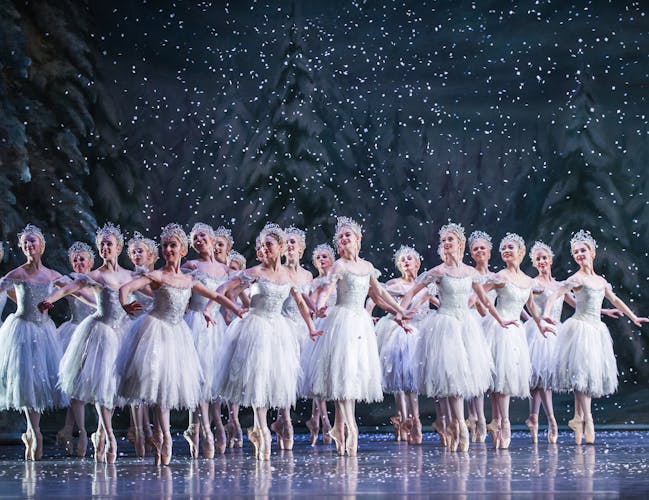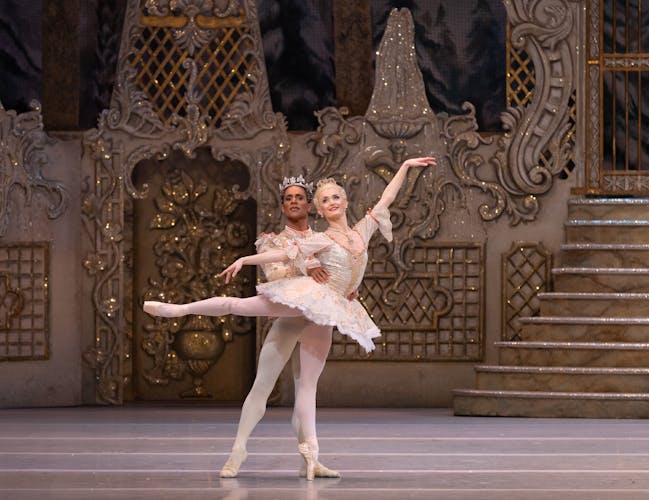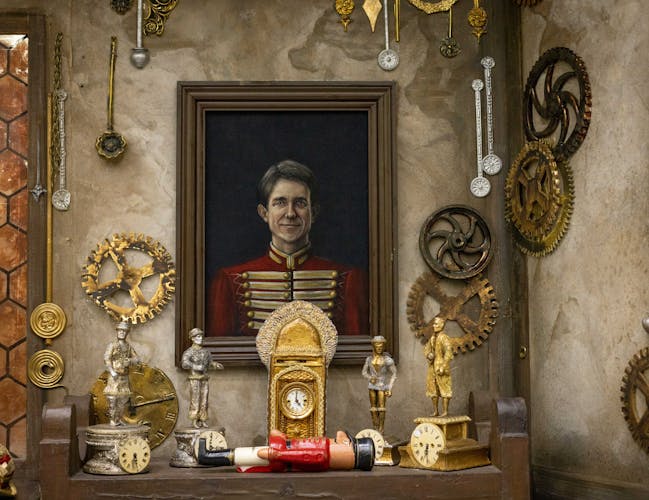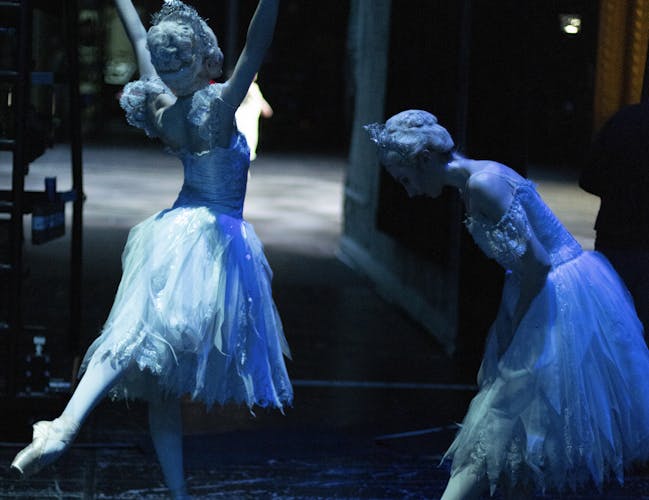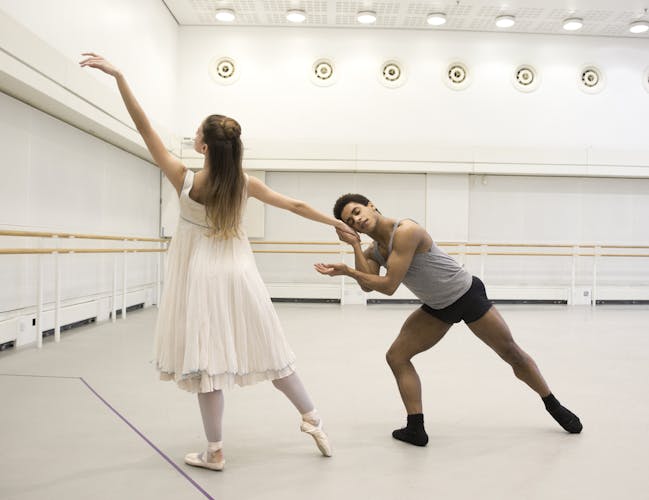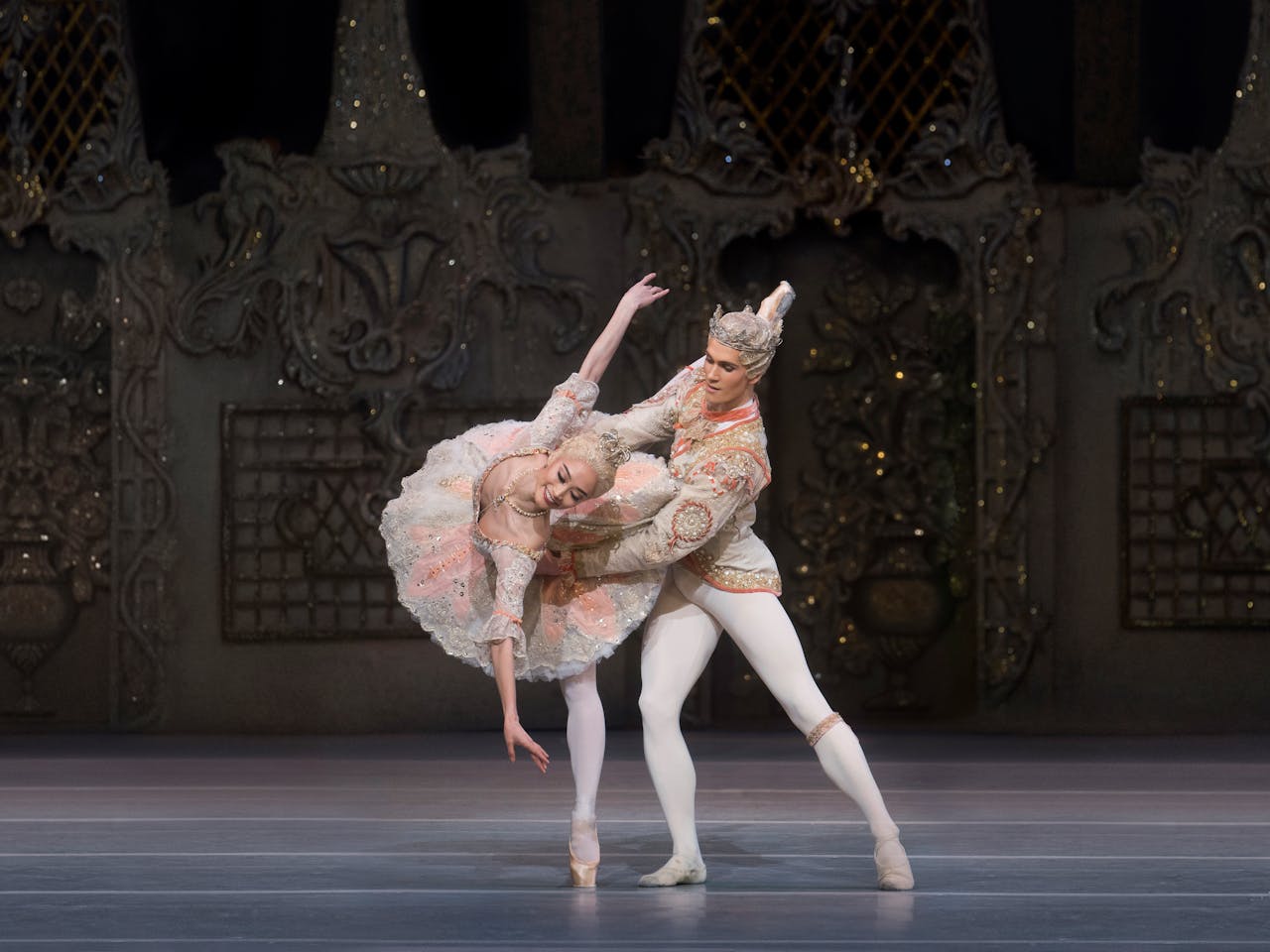The Nutcracker
Our quick guide to this enchanting, festive ballet, suitable for the whole family.
Peter Wright’s much-loved production for The Royal Ballet, with gorgeous period designs by Julia Trevelyan Oman, keeps true to the spirit of this festive ballet classic, combining the thrill of the fairy tale with spectacular dancing. It is the perfect Christmas treat for all the family.
Discover more about the brilliance of Tchaikovsky’s score, and learn about Clara and her enchanted Nutcracker fighting the Mouse King and visiting the Sugar Plum Fairy in the glittering Kingdom of Sweets.
Quick Facts
What is The Nutcracker about?
Loosely based on a story by E.T.A. Hoffmann, the ballet begins in the 19th-century German home of the Stahlbaums, where they are hosting a lively Christmas party. Clara is given an enchanted Nutcracker doll on Christmas Eve. As midnight strikes, she creeps downstairs to find a magical adventure awaiting her and her Nutcracker.
The magician Drosselmeyer transforms the drawing room for a battle between mice and toy soldiers. During the battle, Clara saves the Nutcracker's life - breaking a magical spell that turned him from a boy to a toy - and the Mouse King is defeated. In celebration, Drosselmeyer sweeps Clara and the Nutcracker off to The Kingdom of Sweets, where they meet The Sugar Plum Fairy and take part in a wonderful display of dances. The next morning, Clara's adventures seem to have been more than just a dream.
How long is the ballet of The Nutcracker?
The performance lasts about 2 hours 20 minutes, including one interval. Act I is 50 minutes long, the interval 30 minutes and Act II 50 minutes.
Who wrote The Nutcracker?
E.T.A Hoffmann's The Nutcracker and the Mouse King was published in 1816. The story was then adapted into a ballet in 1892. The Royal Ballet have been performing the ballet since their foundation in 1931 and the current production of The Nutcracker that they perform was choreographed by Sir Peter Wright in 1984.
Who composed The Nutcracker?
The Nutcracker was created into a ballet in 1892, with music by Pyotr Ilyich Tchaikovsky and choreography by Marius Petipa and Lev Ivanov.
Why is The Nutcracker so famous?
Christmas wouldn’t be Christmas without sugar, which may be one of the reasons behind The Nutcracker’s enduring festive popularity. One of the ballet's central characters, The Sugar Plum Fairy, is associated with one of the most recognisable pieces of Tchaikovsky's music which has since become associated with Christmas festivities throughout Europe and beyond.
History
Magic through the years
Taking E. T. A. Hoffmann's story, Marius Petipa collaborated once again with Pyotr Ilyich Tchaikovsky to create a ballet version of The Nutcracker. After the success of The Sleeping Beauty (first performed in 1890),The Nutcracker was first performed on 17 December 1892, at the Mariinsky Theatre in St. Petersburg, Russia. It was not particularly successful, receiving criticism, particularly for the choreography created for The Sugar Plum Fairy. Unfortunately Tchaikovsky died less than a year later, without knowing what a success the ballet would later become.
The Royal Ballet's history with The Nutcracker goes back to its origins as the Vic-Wells Ballet. In 1934 they were the first company outside of Russia to stage a new version of Tchaikovsky's famous ballet, with the production created by Nicholas Grigorievich Sergeyev. In 1951, The Royal Ballet's Company Founder Choreographer Frederick Ashton decided to stage another new version with designs by British photographer Cecil Beaton. In this version, the Stalbaum's Christmas part was omitted from Act I, with more focus given to the group dances that the characters in the Kingdom of Sweets perform in Act II. At this time, the 'sweets' were still as in the original work a dance representation of the exotic sweet delights found around the world. This included 'Coffee from Arabia' (Music: Arabian Dance Op. 71 Act III No. 12b), 'Chocolate from Spain' (Music: Spanish Dance Op. 71 Act III No. 12a), and 'Crystallized Flower' (Music: Waltz of the Flowers Op. 71 Act III No. 13).
The Royal Ballet also performed a new, dramatic version created by dancer Rudolf Nureyev in 1968. Nureyev had danced the role many times in his career in Russia and retained some traditional elements in the costumes and the staging, including the candle-lit Christmas tree. However, he took a psychoanalytical approach to the story, telling it from Clara's perspective as she searches for the man of her dreams.
By far the longest-standing version of the production in the Company's history is that created by Sir Peter Wright, in 1984. The Royal Ballet continue to perform this production now, 40 years later. At The Nutcracker's 30th anniversary in 2013 Peter Wright said: ‘One has to be open to new ideas because the worse thing would to be to become a museum piece’.
The Nutcracker has become a Christmas tradition for The Royal Ballet, who have performed it almost 600 times since 1984. Families travel from around the UK and beyond to watch this magical, festive spectacle.
The Nutcracker Synopsis
- Clara – a young girl
- Dr Stahlbaum – her father
- Mrs Stahlbaum – her mother
- Fritz – her brother
- Herr Drosselmeyer – a relation, a magician
- Hans-Peter/The Nutcracker – Herr Drosselmeyer's newphew, trapped inside a Nutcracker doll
- Harlequin, Columbine, Soldier and Vivandière – Dolls that Herr Drosselmeyer brings to life
- Mouse King – Clara and the Nutcracker battle the Mouse King
- The Sugar Plum Fairy – ruler of The Kingdom of Sweets
- Her Prince – ruler of The Kingdom of Sweets
When Drosselmeyer is invited to entertain the guests at a Christmas party that his friends, the Stahlbaums, are giving, he decides that this could well be the opportunity he has been looking for.
Their daughter, Clara, is a little younger than Hans-Peter, who is magically imprisoned in the Nutcracker. What better time than Christmas, when the mice are busy stealing the leftovers, for a confrontation between the Mouse King and the Nutcracker? He decides to put the Nutcracker in the tender care of Clara and makes a special Christmas Angel to guide her through her task.
When all the guests have departed and the house is asleep, Clara, in search of the Nutcracker, creeps downstairs and discovers Drosselmeyer waiting for her. He draws her into his own special world of fantasy where time is suspended, and exerts all his powers to transform the living room into a great battlefield and summons the Mouse King. In the ensuing fight between the mice and the toy soldiers the Nutcracker defeats the Mouse King, but only through the intervention of Clara, who, out of compassion, saves the Nutcracker’s life. Transformed into his real self, he dances with Clara and they find themselves in The Land of Snow. Drosselmeyer then sends them on a magic journey to the Sugar Garden in The Kingdom of Sweets where they meet The Sugar Plum Fairy and her Prince.
Freed at last from his imprisonment inside the Nutcracker, Hans-Peter recounts to The Sugar Plum Fairy his great adventure and how Clara saved his life. They then join in a magnificent entertainment put on by Drosselmeyer to honour them for their bravery.
Returning to reality, Clara runs out into the street in search of Drosselmeyer and encounters a strangely familiar young man, while back in his workshop Drosselmeyer prays that his efforts will be rewarded. His nephew returns; the spell has indeed been broken.
Written by Peter Wright
Pictures and videos
Gallery
Gallery
Production
Sugary Sweet Choreography
One of the most awaited moments in The Nutcracker is the Grand Pas de deux in Act II. It is part of the entertainments in The Kingdom of Sweets to reward Clara for her help in saving the life of The Nutcracker/Hans-Peter and defeating the Mouse King. It comes after a series of short group dances (called divertissements) that includes Dance of the Mirlitons (little flutes) and the Waltz of the Flowers. A pas de deux is a centrepiece that allows two star dancers to shine with their technique, communication of emotion and especially their partnering – the sympathetic way they respond to each other. In classical ballets the pas de deux is usually for a male and female principal (and thus in the story so often between two lovers): here it is with The Sugar Plum Fairy and her Prince.
There is a general pattern for a classical pas de deux. First the two Principals enter and dance a slow section together (the Adagio), then they each have a solo number (called a Variation) and finally they dance together in a spectacular and usually fast conclusion (the Coda). For the first section of the pas de deux between The Sugar Plum Fairy and her Prince, the choreographer Petipa asked the composer Tchaikovsky for ‘an adagio intended to produce a colossal impression’ – which is just what Tchaikovsky delivered. After a few chords of introduction, and unexpectedly in the middle of a bar, a striking and soulful cello melody begins. Tchaikovsky transforms this unlikely material into a powerfully expressive melody, using repetitions matched with increasingly full and intense sound. The choreography focuses on the beauty of the line of the two solo dancers, treated as one as they flow gracefully into a series of momentary striking images of beautiful shapes and gravity-defying lifts and balances.
The Variation for the Prince (known as the Tarantella Op. 71 Act III 14b) is musically almost understated at the start. The twisting and hopping quality of the melody is paired with choreography that seems equally understated in making a series of impressive and vigorous jumps and leaps seem effortless. Next, The Sugar Plum Fairy has her Variation (known as the Dance of The Sugar Plum Fairy Op. 71 Act III 14c) , which contrasts the Prince by showing lightness in contact with the ground through her beautifully precise and delicate movements, poised on pointe. Petipa asked here for music that sounded ‘as if drops of water were shooting out of fountains’, and Tchaikovsky matched this description superbly to the sounds of the celesta, the solo instrument that has helped make this one of the most immediately recognizable of all pieces of Tchaikovsky ballet music.
To finish, the two dancers come back together for a shared flourish of agility, supported by wonderfully vigorous and assertive music – marked to be played allegro assai (very fast). Over steady chords sails a catchy, flowing melody that breaks out into furious runs of scales and then decorative figures and trills, capturing perfectly the energy and speed of the dancers. At the end, The Sugar Plum Fairy is in the arms of her Prince once more – and the whole joyful Grand Pas de deux becomes a summary of how choreography, superb technique, wonderful music and the thrill of performance can make ballet so extraordinary and uplifting.
Catchy Christmas melodies
The music from The Nutcracker is commonly used throughout the festive period. Audiences will have undoubtably heard some of the most memorable melodies – including the 'March of the Toy Soldiers, 'Waltz of the Flowers' and 'Dance of The Sugar Plum Fairy – in advertisements, department stores and parades.
The 1940's film classic Disney's Fantasia used many of the pieces. The magic of Tchaikovsky's music is matched by fantastical animation: pixies awaken to the iconic sound of the celeste of the 'Dance of The Sugar Plum Fairy', mushrooms dance to 'The Chinese Dance', blossoms bloom to the 'Dance of the Mirlitons', fish swim to 'The Arabian Dance' and thistles and orchids perform a Russian 'Trepak' Dance. The magic of the 'Waltz of the Flowers' is brought to life through fairies that bring the forest to life.
The Nutcracker features in another popular Christmas Classic – Home Alone. Once again the sweet, delicate sound of the 'Dance of The Sugar Plum Fairy' is used, but not associated with fairy-like characters. It is mainly associated with the comic burglars Harry and Marv, as they attempt to break into the house. The 'Trepak'/Russian Dance is also used, but in parody. Rather than the strong Cossack dance style that Petipa choreographed to this music, the McAllisters are seen rushing round the house in a bid to get to the airport in time. Using these two themes, John Williams sets a Christmas sound world. He also provides comedy; without a graceful dancer in sight, audiences are reminded just how chaotic this film is.
In 2001 the first in a series of Barbie films were released. Barbie in The Nutcracker sold over 3.5 million copies and was the beginning of a range of ballet-themed Barbie films, dolls and more. The animated film is based on the story of E.T.A.Hoffmann and uses Tchaikovsky's score. There were some edits to the original story with Herr Drosselmeyer being replaced with a kindly aunt and The Sugar Plum Fairy being renamed the Sugarplum Princess. The animation was 'choreographed' by dancer and choreographer Peter Martins with inspiration from New York City Ballet's production of The Nutcracker.
Watch more
You can watch a special screening of The Nutcracker from 2023 in cinemas from Tuesday 17 December 2024.
- CINEMA
The Nutcracker
Discover the enchantment of ballet with this sparkling festive treat for the whole family.
Special screening in cinemas: from Tuesday 17 December 2024
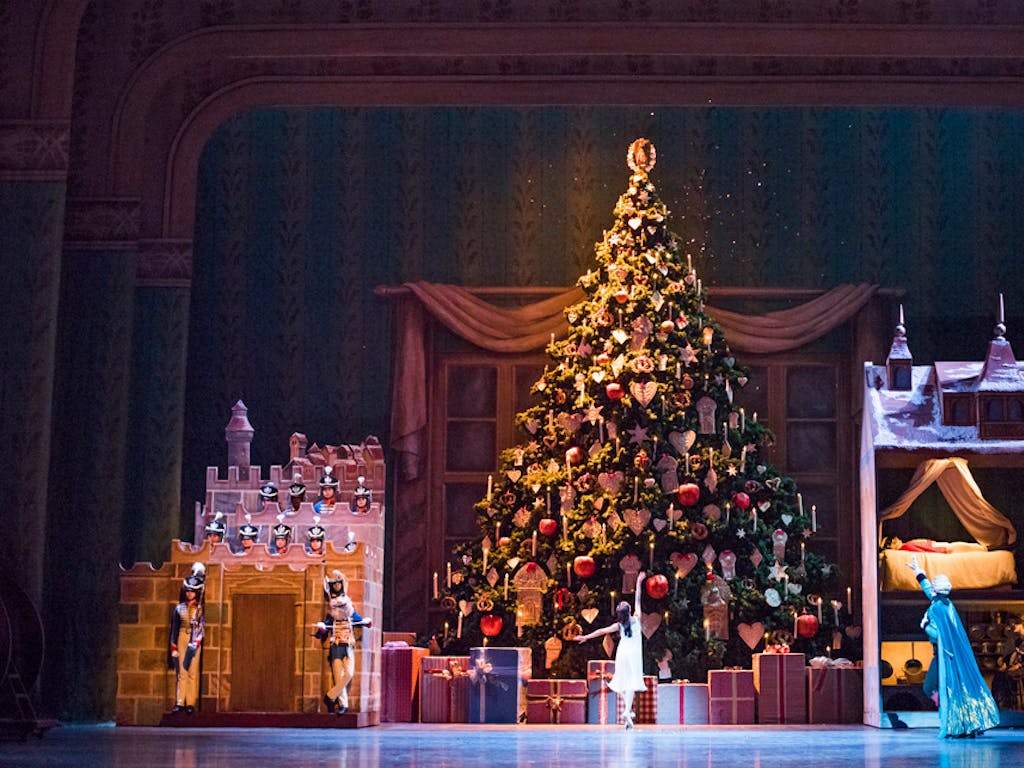
You can watch the production as well as behind-the-scenes insights, interviews and introductions on Royal Ballet and Opera Stream.
Stream now
Royal Opera House Covent Garden Foundation, a charitable company limited by guarantee incorporated in England and Wales (Company number 480523) Charity Registered (Number 211775)
